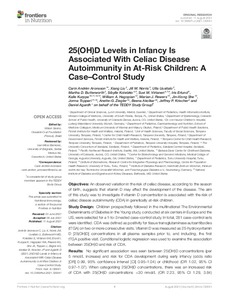25(OH)D Levels in Infancy Is Associated With Celiac Disease Autoimmunity in At-Risk Children: A Case–Control Study
Aronsson Carin Andrén; Liu Xiang; Norris Jill M.; Uusitalo Ulla; Butterworth Martha D.; Koletzko Sibylle; Virtanen Suvi M.; Erlund Iris; Kurppa Kalle; Hagopian William A.; Rewers Marian J.; She Jin-Xiong; Toppari Jorma; Ziegler Anette-G.; Akolkar Beena; Krischer Jeffrey P.; Agardh Daniel; TEDDY Study Group
https://urn.fi/URN:NBN:fi-fe2021120158472
Tiivistelmä
Objectives: An observed variation in the risk of celiac disease, according to the season of birth, suggests that vitamin D may affect the development of the disease. The aim of this study was to investigate if vitamin D concentration is associated with the risk of celiac disease autoimmunity (CDA) in genetically at-risk children.
Study Design: Children prospectively followed in the multinational The Environmental Determinants of Diabetes in the Young study, conducted at six centers in Europe and the US, were selected for a 1-to-3 nested case-control study. In total, 281 case-control sets were identified. CDA was defined as positivity for tissue transglutaminase autoantibodies (tTGA) on two or more consecutive visits. Vitamin D was measured as 25-hydroxyvitamin D [25(OH)D] concentrations in all plasma samples prior to, and including, the first tTGA positive visit. Conditional logistic regression was used to examine the association between 25(OH)D and risk of CDA.
Results: No significant association was seen between 25(OH)D concentrations (per 5 nmol/L increase) and risk for CDA development during early infancy (odds ratio [OR] 0.99, 95% confidence interval [CI] 0.95-1.04) or childhood (OR 1.02, 95% CI 0.97-1.07). When categorizing 25(OH)D concentrations, there was an increased risk of CDA with 25(OH)D concentrations < 30 nmol/L (OR 2.23, 95% CI 1.29, 3.84) and > 75 nmol/L (OR 2.10, 95% CI 1.28-3.44) in early infancy, as compared with 50-75 nmol/L.
Conclusion: This study indicates that 25(OH)D concentrations 75 nmol/L during early infancy were associated with an increased risk of developing CDA in genetically at-risk children. The non-linear relationship raises the need for more studies on the possible role of 25(OH)D in the relation to celiac disease onset.
Kokoelmat
- Rinnakkaistallenteet [27094]
